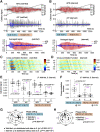Neural Coding of Thermal Preferences in the Nematode Caenorhabditis elegans
- PMID: 32253198
- PMCID: PMC7322292
- DOI: 10.1523/ENEURO.0414-19.2020
Neural Coding of Thermal Preferences in the Nematode Caenorhabditis elegans
Abstract
Animals are capable to modify sensory preferences according to past experiences. Surrounded by ever-changing environments, they continue assigning a hedonic value to a sensory stimulus. It remains to be elucidated however how such alteration of sensory preference is encoded in the nervous system. Here we show that past experiences alter temporal interaction between the calcium responses of sensory neurons and their postsynaptic interneurons in the nematode Caenorhabditis elegansC. elegans exhibits thermotaxis, in which its temperature preference is modified by the past feeding experience: well-fed animals are attracted toward their past cultivation temperature on a thermal gradient, whereas starved animals lose that attraction. By monitoring calcium responses simultaneously from both AFD thermosensory neurons and their postsynaptic AIY interneurons in well-fed and starved animals under time-varying thermal stimuli, we found that past feeding experiences alter phase shift between AFD and AIY calcium responses. Furthermore, the difference in neuronal activities between well-fed and starved animals observed here are able to explain the difference in the behavioral output on a thermal gradient between well-fed and starved animals. Although previous studies have shown that C. elegans executes thermotaxis by regulating amplitude or frequency of the AIY response, our results proposed a new mechanism by which thermal preference is encoded by phase shift between AFD and AIY activities. Given these observations, thermal preference is likely to be computed on synapses between AFD and AIY neurons. Such a neural strategy may enable animals to enrich information processing within defined connectivity via dynamic alterations of synaptic communication.
Keywords: C. elegans; behavioral preference; emotion; phase coding; thermotaxis.
Copyright © 2020 Matsuyama and Mori.
Figures




Similar articles
-
OLA-1, an Obg-like ATPase, integrates hunger with temperature information in sensory neurons in C. elegans.PLoS Genet. 2022 Jun 8;18(6):e1010219. doi: 10.1371/journal.pgen.1010219. eCollection 2022 Jun. PLoS Genet. 2022. PMID: 35675262 Free PMC article.
-
Reconstruction of Spatial Thermal Gradient Encoded in Thermosensory Neuron AFD in Caenorhabditis elegans.J Neurosci. 2016 Mar 2;36(9):2571-81. doi: 10.1523/JNEUROSCI.2837-15.2016. J Neurosci. 2016. PMID: 26936999 Free PMC article.
-
Genetic screens identified dual roles of microtubule-associated serine threonine kinase and CREB within a single thermosensory neuron in the regulation of Caenorhabditis elegans thermotaxis behavior.G3 (Bethesda). 2022 Nov 4;12(11):jkac248. doi: 10.1093/g3journal/jkac248. G3 (Bethesda). 2022. PMID: 36102820 Free PMC article.
-
Environmental-temperature and internal-state dependent thermotaxis plasticity of nematodes.Curr Opin Neurobiol. 2022 Jun;74:102541. doi: 10.1016/j.conb.2022.102541. Epub 2022 Apr 18. Curr Opin Neurobiol. 2022. PMID: 35447377 Review.
-
Temperature signaling underlying thermotaxis and cold tolerance in Caenorhabditis elegans.J Neurogenet. 2020 Sep-Dec;34(3-4):351-362. doi: 10.1080/01677063.2020.1734001. Epub 2020 Apr 21. J Neurogenet. 2020. PMID: 32316810 Review.
Cited by
-
Aberrant neuronal hyperactivation causes an age-dependent behavioral decline in Caenorhabditis elegans.Proc Natl Acad Sci U S A. 2025 Jan 7;122(1):e2412391122. doi: 10.1073/pnas.2412391122. Epub 2024 Dec 31. Proc Natl Acad Sci U S A. 2025. PMID: 39739791 Free PMC article.
-
Multisite regulation integrates multimodal context in sensory circuits to control persistent behavioral states in C. elegans.Nat Commun. 2023 May 26;14(1):3052. doi: 10.1038/s41467-023-38685-1. Nat Commun. 2023. PMID: 37236963 Free PMC article.
-
Analyses of Neural Circuits Governing Behavioral Plasticity in the Nematode Caenorhabditis elegans.Methods Mol Biol. 2024;2794:321-330. doi: 10.1007/978-1-0716-3810-1_27. Methods Mol Biol. 2024. PMID: 38630241
-
Feeding state functionally reconfigures a sensory circuit to drive thermosensory behavioral plasticity.Elife. 2020 Oct 19;9:e61167. doi: 10.7554/eLife.61167. Elife. 2020. PMID: 33074105 Free PMC article.
-
OLA-1, an Obg-like ATPase, integrates hunger with temperature information in sensory neurons in C. elegans.PLoS Genet. 2022 Jun 8;18(6):e1010219. doi: 10.1371/journal.pgen.1010219. eCollection 2022 Jun. PLoS Genet. 2022. PMID: 35675262 Free PMC article.
References
Publication types
MeSH terms
Substances
LinkOut - more resources
Full Text Sources
Miscellaneous
